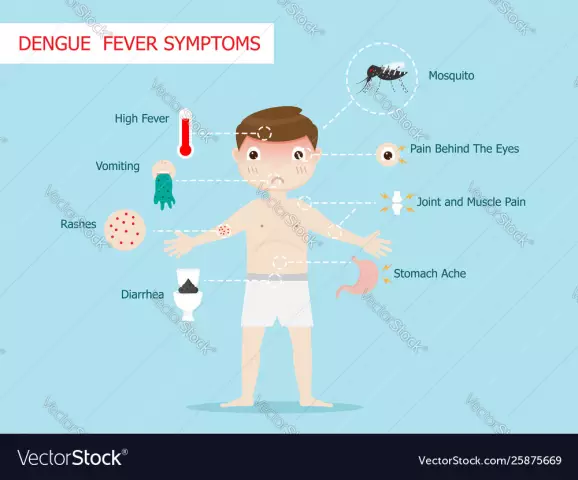- Author Rachel Wainwright [email protected].
- Public 2023-12-15 07:39.
- Last modified 2025-11-02 20:14.
Hemorrhagic syndrome

Due to changes in one or several links of hemostasis, there is a tendency to bleeding of the mucous membranes and to cutaneous hemorrhage, which is called hemorrhagic syndrome.
In medicine, there are five types of syndrome, namely:
- Bruised, or petechial-spotted - typical for thrombocytopathy, hereditary deficiency of coagulation factors, thrombocytopenia, dysfibrinogenemia and hypofibrinogenemia. With hemorrhagic syndrome of this type, there is a deficiency of II, V and X coagulation factors;
- Hematoma - occurs against the background of hemophilia A and B, is characterized by a deficiency of VIII, IX and XI coagulation factors. The patient gradually develops a dysfunction of the musculoskeletal system, there are intense painful hemorrhages in soft tissues and joints. A few hours after the injury, late bleeding, characteristic of this type of syndrome, begins;
- Microcirculatory-hematoma, or mixed - is typical for disseminated intravascular coagulation and von Willebrand disease, often occurs with an overdose of thrombolytics and anticoagulants, severe deficiency of prothrombin complex factors, the appearance of immune inhibitors of factors VIII and IX in the blood. The mixed hemorrhagic syndrome is characterized by a combination in the intestinal wall and retroperitoneal space of separate large hematomas with petechial-spotty skin hemorrhages;
- Vasculitic-purple - develops against the background of immune and infectious vasculitis, is characterized by the development of hemorrhages on an inflammatory basis in the form of erythema or rash, it is characterized by the addition of intestinal bleeding and nephritis. This type of syndrome is easily transformed into DIC syndrome;
- Angiomatous - develops in the zones of arteriovenous shunts, angiomas and telangiectasias, it is characterized by the formation of persistent local hemorrhages associated with zones of vascular pathology.
According to statistics, hemorrhagic syndrome occurs in women more often than in men.
Hemorrhagic syndrome: causes and symptoms
Damage to the vascular wall and its structure, the number and functions of platelets, as well as a violation of coagulation hemostasis are the causes of the development of hemorrhagic syndrome. In some cases, pathologies are common, in others they are extremely rare, which is important to consider when diagnosing the disease.
The acquired form of the syndrome most often develops against the background of secondary thrombocytopathy and thrombocytopenia, deficiency of factors of the prothrombin complex, disseminated intravascular coagulation syndrome and hemorrhagic vasculitis.
Recently, the development of hemorrhagic syndrome is increasingly associated with the use of drugs that disrupt platelet aggregation and blood clotting. Also, the cause of the development of the syndrome may be Wergolf's disease, hemophilia and prothrombin deficiency.
Symptoms of the syndrome are fainting, bleeding of various types and degrees of complexity, as well as bleeding (hemorrhagic diathesis).
Hemorrhagic syndrome in newborns
The consequence of insufficient synthesis of Thrombin Index factors is hemorrhagic syndrome (disease) of newborns. Due to the deficiency of vitamin K in children, it occurs in the form of congenital coagulopathy.
According to statistics, 20 years ago, hemorrhagic syndrome in newborns occurred in 0.25-0.5% of cases; today, the widespread use in clinical practice of 1 mg dose of vitamin K has reduced this indicator to 0.01% or less.
The development of the syndrome in newborns can be due to several factors, namely:
- Taking by a pregnant woman of antibiotics, anticonvulsants and anti-tuberculosis drugs, indirect anticoagulants that penetrate the placenta;
- Late breastfeeding, prematurity, perinatal hypoxia and long-term parenteral nutrition;
- Malabsorption syndrome, the use of broad-spectrum antibiotics for the child and artificial feeding.
In rare cases, hemorrhagic syndrome in a newborn manifests itself on the first day of life, more often it develops on days 5-7.
Diagnostics of the hemorrhagic syndrome
First of all, to confirm the diagnosis, it is necessary to conduct a detailed analysis of blood and urine, the simplest coagulation tests, to count platelets in peripheral blood, if indicated, a sternal puncture may be required.
When making a diagnosis, the doctor should take into account the duration of bleeding and the time of blood coagulation, check it for the content of fibrinogen and prothrombin, and also determine the tolerance (resistance) of plasma to heparin.
Prevention and treatment of hemorrhagic syndrome
To prevent the development of the syndrome in newborns, the following preventive measures are recommended:
- Inject vitamin K subcutaneously in premature infants;
- Apply a newborn baby to the breast in the first half hour after birth.

Treatment of hemorrhagic syndrome in infants occurs through intramuscular injection of vitamin K, as well as feeding the infant with expressed mother or donor breast milk seven times a day.
Regardless of the age of the patient, if bleeding develops, emergency medical care should be provided to stop it. To prevent the development of bleeding, adult patients may be prescribed hemostatics that increase blood clotting. On an individual basis, depending on the indications and the patient's condition, the doctor may prescribe subsequent drug treatment.
Hemorrhagic syndrome in women, men and newborns manifests itself as a tendency to bleeding of the mucous membranes and cutaneous hemorrhages. Patients need urgent hospitalization and the use of adequate treatment, including stopping bleeding, restoring the level of vitamin K in the body, as well as the use of drugs that increase blood clotting.
YouTube video related to the article:
The information is generalized and provided for informational purposes only. At the first sign of illness, see your doctor. Self-medication is hazardous to health!






